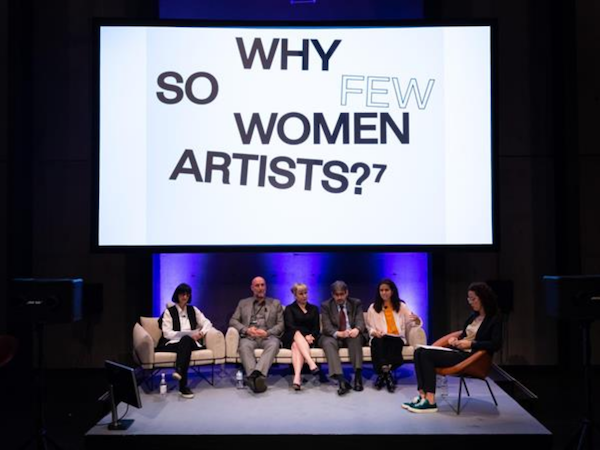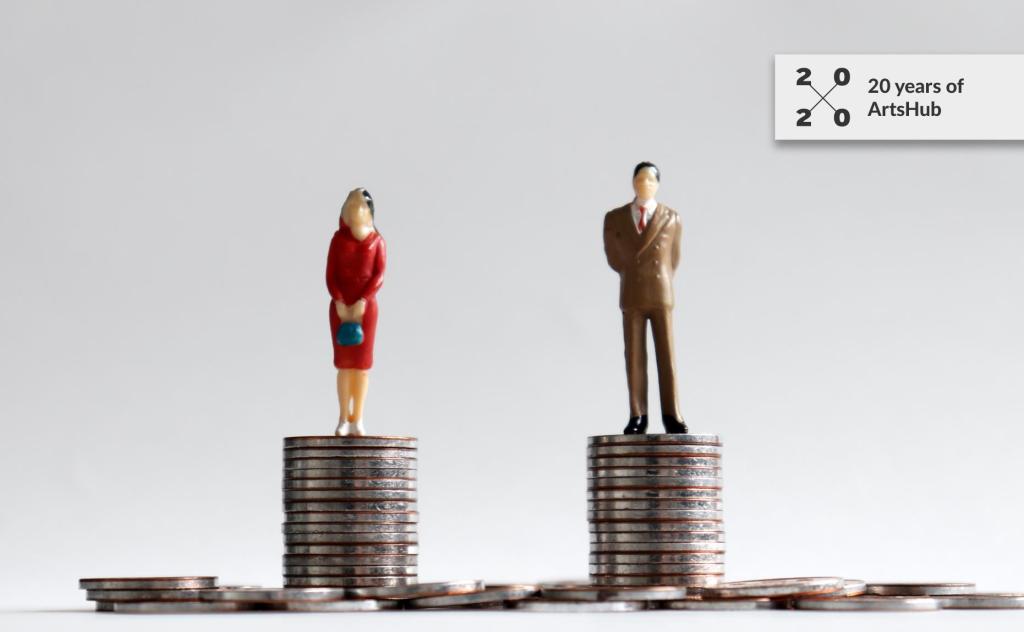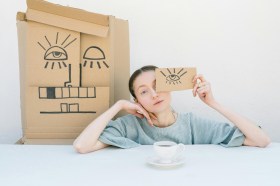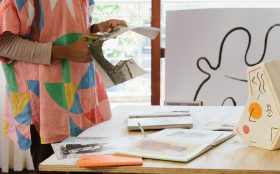Looking back through the archives as part of ArtsHub’s 20th anniversary, we reflect on the milestones stories that have shaped the arts sector and also consider what still needs to improve.
Today is International Equal Pay Day. In this piece, first published in September 2018, ArtsHub covered a long overdue conversation about gender imbalance in the art market, at an event presented by Sydney Contemporary.
This is one of our most read stories.
* * *
While major public institutions are increasingly called upon to address gender biases within their programming, their acquisitions, their boards, as well as staffing, it would appear from recent research by The Countess Report – a research project established in 2008 by artist Elvis Richardson to collect data on the representation of women in the visual arts industry – that the art market and the education sector are still a long way from reaching parity.
‘The future is looking remarkably similar to the present,’ said Countess representative Miranda Samuels.
Samuels was part of a panel discussion at the 2018 Sydney Contemporary art fair, which was an appropriate venue for the gendered market debate.

Sydney Contemporary panel ‘Sheilas in the art market’. Photo credit: Jacquie Manning.
She reported that while the premiere Aussie fair was sitting pretty well in terms of its gender balance – of the artists presented in the fair’s Current section 42% presented were female – these figures were not reflective of a broader market sector.
Remembering that art magazines are an important market tool, Samuels reported that only 34% of the feature articles and reviews were about female artists, while the covers only featured 20% women.
‘We all know a cover story will boost reputation and the cult of personality in building a career, so this is an important statics that we must pay attention to,’ she said.
Merryn Schriever, CEO of Bonhams agreed: ‘The focus is heavily directed towards men in the [secondary] market and that bias shows through with what goes on the catalogue cover, how a catalogue is put together, and how works are preferenced in auctions, and that is why – not just in the Australian market but also the US market – you see 90% of the values captured in male artists.’
Schriever made the point that in the secondary market, of the top ten selling Australian artists nine are men.
‘Like does speak to like in some ways, and we are looking at an industry that is heavily male dominated. The museums are probably redressing that in a more efficient and effective way – we have just seen the first female director appointed by the Art Gallery of South Australia and that took 138 years – but certainly in the auctions houses, it is a very masculine world,’ said Schriever.
She continued that only 14% of all auctioneers are women, and that a woman only took the rostrum for first time for a major sale in 1990.
Associate Professor Marco Navone, of UTS, said his research confirmed Schriever’s view: ‘We collected 1.9 – 2 million observations from 1970 – 2016 of paintings sold at auction in 49 countries, and what we observed on average was that female artists were discounted 40% compared to male.’
Curiously, Australia sits in the middle of gender trends in the market.
Navone believes the difference is cultural, not genetics. Observations over time show that the gender gap is decreasing, and simply genetics do not change. He also said commented that the varying rate of bias from country to country, also does not point to a genetic argument – placing gender discounting exclusive within a learnt or culture territory.
It’s not genetic; it’s culture
To prove this point, Navone and his research team created some fake paintings and showed them to 2,000 people to test their theory on whether gender bias is taught.
‘We associated with painting sometimes with a man and sometimes woman. The results showed that for some people, association with the name of man increases the value of the artworks while for a woman it decreased – yet it was exactly the same painting,’ explained Navone.
In a stark realisation, his team’s research further showed that the more people go to museums and are culturally active, the stronger their bias grows towards male artists. ‘We think this point proves that the gender gap comes from attitudes,’ said Navone.
He also made the point that where women held a seat in Parliament internationally the gender discount gap reduced in favour of women artists, which clearly points to the acceptance of equality within power structures.
Read: The cost of gender imbalance in the arts (2012) – Deborah Stone
Marion Borgelt has felt this bias first hand as a female artist.
‘If you earn a lot of money from your art as a woman, it starts to go around you are only interested in money. I don’t know why we can’t be business people running a successful small business?’
With a thirty-year career behind her, and a reputation for public and corporate commission work, Borgelt made the point that in the business world it is largely men who make the decision on a commission.
‘The people who bring the art to those men [to select, however] are women, and in this city [Sydney] we have some fabulous private art consultants and about 75% are women,’ she observed.
Borgelt continued: ‘Here is the rub, however, when it goes to private homes. Women don’t have control of the purse strings and they have to go to the men to purchase a work of art – and if there is a dispute – then it’s likely that my work won’t get bought.’
Schriever added that women are ‘more reticent about commerciality, to talk about money and claim their place at the table.’
It starts with education
Samuels believes it largely has to do with education, that creates this chain-cycle of bias. It is the focus area of a new Countess Report is due to be released next year which looks at how gender biases in the curriculum might entrench inequity in the arts world.
Samuels reported that the High School art experience is through gendered eyes. While a majority 75% of students studying visual art are women, exam papers almost exclusive ask students to respond to work of male artists – only 16% are examples by women.
In the next tier, there is an average of 75% female enrolments at art schools.
Read: Fair pay for artists in world-leading Irish policy (2020) – Esther Anatolitis
Our museums also play a role in the education/perception shift. The Royal Academy in London recently announced that for its forthcoming exhibition of Renaissance art, it would ensure an equal gender split of naked men and women displayed.
The debate was escalated in Australia this week with the article, ‘How art museums finally opened their eyes to Australian women artists’, which curiously coincided with an article by the American blog, Hyperallergic, which raised the question of the ‘Pros and Cons of All-Women’s Art Shows’ canvassing comments from leading curators.
This is a topic that has gained greater traction and visibility in the wake of the #metoo movement, but how do we seize that for real change?
How can we do more to reach parity?
The question of quotas was raised by panel chair Angela Goddard, director of the Griffith University Art Museum and SHEILA board member.
‘I have no doubt that we can do far better in terms of gender equality than what is being achieved now, without compromising on the quality of the work. I don’t think many people would be in favour for mandated quotas, but there is an ethical question at stake here,’ Goddard said.
Sydney Contemporary director Barry Keldoulis said that while quotas were an interesting proposition, he was less in favour of the idea, adding that quotas reinforce the idea that women’s art is different to art made by men.
‘As fair director I have to encourage quality so I can’t be prescriptive over the gender of the artists in the gallery’s show,’ he said.
Read: Know my name – and don’t forget it (2019)
However, the Freize Art Fair’s Artistic director Jo Stella-Sawicka recently announced it would include a section dedicated to British female artists of the 1980s, who had not have representation in museum spaces, reviews and had been excluded from that market place. Stella-Sawicka told Go London: ‘I spent my youth going to big shows of white male painters.’
The decision was inspired by research carried out last year by the Freelands Foundation – akin to Australia’s Countess Report – which reported that just 22% of solo shows presented by major London non-commercial galleries last year were by women artists – a figure which was down on the previous year. Should all art fairs be following this lead?
Schriever continued: ‘You can make positive change in commercial environments like the Frieze Art Fair that carved out a space – they made that choice to do that.’ She added that you can also make positive choices by including the work of women artists more prominently in auction and museum catalogues, to shift the power play.
Schriever also believes that women artists need to speak out more. ‘In an auction environment, if you have a male artist and they are not happy with a catalogue entry, your photo, your estimate or how you hang it, they are going to let you know – women don’t – they never do.’
There was a further suggestion that to ensure better gender balance through succession in our public institutions, there should be legislations introduced to cap tenures, allowing senior professional women to move up within the cultural sector.
Samuels said: ‘We need to find a way to care about this.’
Sheilas in the art market was presented by SHEILA – The Foundation for Women in Visual Art and the Copyright Agency on 12 September 2018. Sydney Contemporary art fair was held at Carriageworks.





